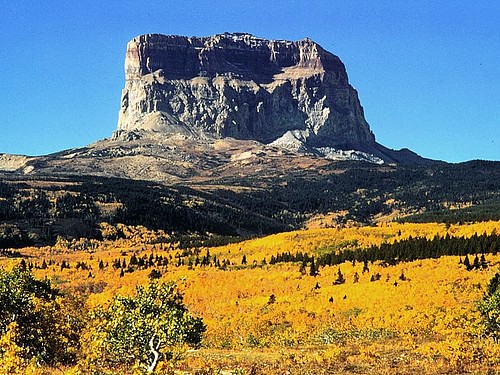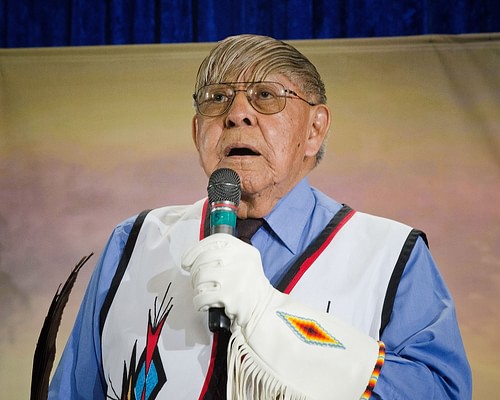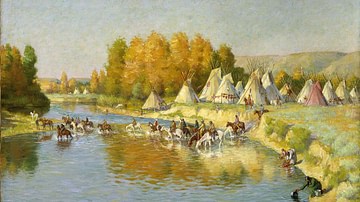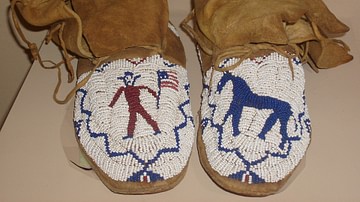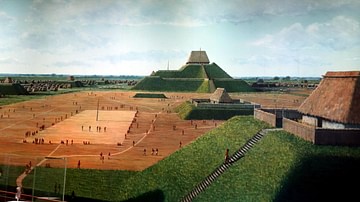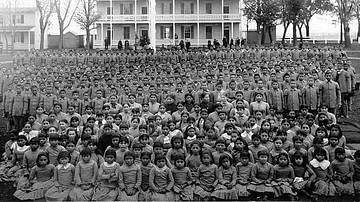The Wise Man of Chief Mountain is an origin story of the Blackfeet nation explaining how they came to wear brightly colored clothing. Although Native American nations generally wore clothing dyed different colors, the Blackfeet were famous for their elaborate dress as well as their colorful tipis. According to this story, that all began with Chief Wise Man.
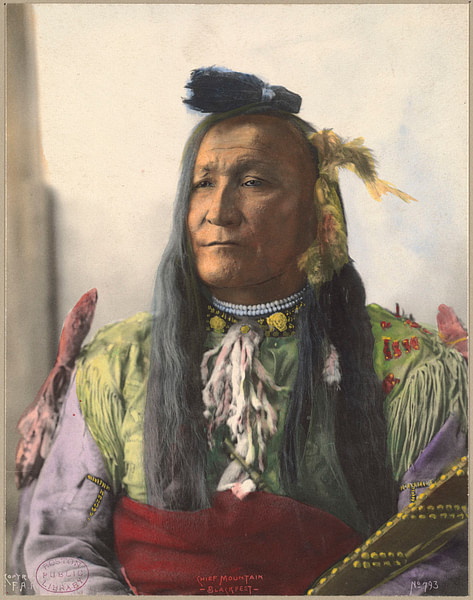
The Blackfoot Confederacy was a group related by language who once held the territory stretching from the North Saskatchewan River in Canada to the Yellowstone River in Montana and across to the Rocky Mountains. Chief Mountain (Ninastako or Ninnahstako in the Blackfoot language), located in Montana, was – and still is – regarded as a sacred site by the Blackfeet nation. In one of the many legends concerning it, Chief Mountain was the site of the beginning of creation by the Supreme Being Nah-too-si, the sun.
Just as the world was created by Nah-too-si at Chief Mountain (or by his messenger and incarnation, Napi), so too, according to this legend, were the brightly colored clothes of the Blackfeet people. After Wise Man and his wife return from his mission to create beautiful clothing, he teaches the people of Chief Mountain how they can do this themselves. The story is still told today by citizens of the Blackfeet nation, and it highlights the cultural value of learning from one's elders and continuing the traditions of the past that define one in the present.
Blackfoot Confederacy & Chief Mountain
The Blackfoot Confederacy (Niitsitapi or Niltsitapi or Siksikaltsitapi meaning "the original people") is a coalition of four nations of the Blackfeet people:
- North Piegan (Northern Pikani)
- South Piegan (Southern Pikani)
- Siksika
- Kainai
The Siksika, Kainai, and North Piegan are First Nations in Canada while the South Piegan live in Montana on the reservation that includes part of Chief Mountain (the other part located in Glacier National Park). The Blackfeet – so-called because of the color of their moccasins – are among the oldest and most prestigious of the Plains Indians, with a history stretching back 10,000 years. Scholar Adele Nozedar, among others, notes how the Blackfeet understand themselves as citizens of the Great Plains, their point of origin, created along with everything else at Chief Mountain. Many modern-day anthropologists and scholars, however, believe they migrated from the northeast beginning c. 1200 BCE.
They are recognized today as one of the many nations that were part of the Plains Indian culture and exemplify that way of life, as Nozedar explains:
Having adopted the horse from other Plains tribes, they roamed after buffalo and lived in tipis in settlements of up to 250 people in up to 30 lodges. Each small band had its leader and relationships between bands were flexible enough for members to come and go between bands as they pleased. In the summer, the bands gathered together; they were among those who performed the Sun Dance ritual. (50)
Their spiritual beliefs, like all Native American nations, informed their understanding of the world, which was recognized as a living thing, created by the Supreme Being with a life force just like all the creatures and plants living on it. The Sun Dance was performed to wake the earth back to life after winter and to give thanks for the sun's gifts while other rituals, performed at Chief Mountain, were performed in gratitude for the act of creation, the maintenance of that creation by various supernatural agencies, to offer up prayers for oneself or the community, or give thanks for prayers answered.
There are many stories concerning the name of Chief Mountain and, among them, is the tale of the young Piegan widow who had just given birth to her first child when her husband, a great war chief, was killed in battle. Unable to endure life without him, she climbed to the top of the mountain with her infant and leaped to her death. Their bodies were laid to rest at the base of the mountain, near her husband, but her soul, and that of her child, were drawn into the mountain by its creative power. According to this tale, one can see the outline of the widow and her child on the mountain's northeast face and the site was given its name in honor of the fallen chief.
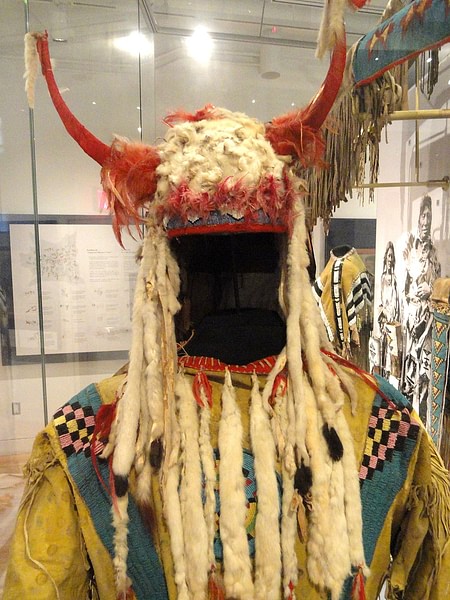
Summary & Commentary
The spiritual energies of the site are recognized in many other stories of the Blackfeet nation, and The Wise Man of Chief Mountain is only one of the best-known. Its popularity is due, in part, to its happy ending in explaining how the people first learned to make the brightly colored clothing they were famous for. Scholar Michael G. Johnson writes:
The Blackfoot historically made beautiful costumes – elaborately decorated men's warrior costumes of shirts and leggings with eagle feather headdresses, and full-length buckskin women's dresses, adorned with beadwork. This ceremonial dress, modified over the years, is still worn at modern powwows, together with an ever-changing array of dancers' costumes. (110)
According to the story, however, this was not always so as, once upon a time, the people only wore plain clothes, without color or distinction. Wise Man – who would have been a figure of spiritual authority, a so-called "medicine man" – recognizes this is a problem and takes himself and his wife away from the daily life of the community to resolve it. Although his journey is not described in any way as a "vision quest", it resonates with a similar purpose in leaving one's life behind for a period to discover one's place in the plan of the Supreme Being and return with a clearly defined spiritual direction for one's life that will benefit the whole community.
In the case of Wise Man, he already knows his direction and place in the wide world and that of his community but needs to provide the people with something he cannot give them while continuing to live as they do. He must remove himself to the area of the Inside Lakes – water symbolizing the creative force of life – to find what he needs to find. After accomplishing his goal, he returns to the people, giving them the gift of color.
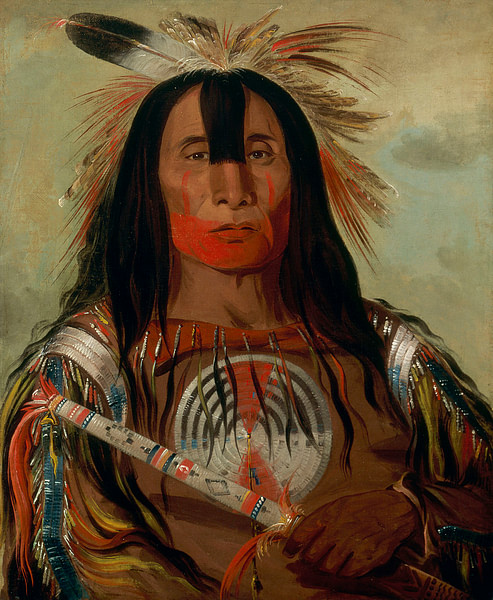
Text
The following text is taken from Voices of the Winds: Native American Legends, edited by Margot Edmonds and Ella Clark. The first two paragraphs are the introduction given in the first English version of the story in Blackfeet Tales of Glacier National Park by James Willard Schultz, published 1916.
Schultz, who became a well-known explorer and writer, married Natahki ("Fine Shield Woman"), a Piegan citizen of the Blackfeet nation, and introduced author, anthropologist, and historian George Bird Grinnell (l. 1849-1938), famous for his works on Native American culture, to the region. Schultz's works, therefore, are considered authoritative English translations of Native American stories.
Chief of the Mountains is grim, rugged, and majestic. Indeed, these are very good reasons for the Blackfeet Indians to have named the awesome peak, Chief Mountain. It is located in Montana, in the northeastern corner of Glacier National Park.
Tribal historian Yellow Wolfe of the Blackfeet tribe always enjoyed telling the following story about Chief Mountain and the people who once lived in its shadow.
Two members of the Blackfeet tribe were Wise Man and his wife. Their people called him Wise Man because he always seemed to know how to do everything right.
At that time, the Blackfeet wore the plainest kinds of clothes. Wise Man thought about this for a long time. One day he said to his wife, "Let us go away for a while. I wish to make some things that I have been planning for a long time."
Wise Man and his wife packed their travois, which was drawn by dogs, and moved to the base of the Inside Lakes. There they made their camp. He hunted and killed enough game for him and his wife and their dogs before beginning work on his plan.
First, he climbed to the high ridge between the lakes and Little River, where he dug an eagle trap. Beside the pit, he laid a deer and slashed its body to attract an eagle. When all was ready, Wise Man jumped into the pit and covered it with willow sticks and grass to make a blind. He waited for an eagle to come. Several eagles, with their wings swishing the air, sailed down upon the deer.
While the eagles ate at the deer, Wise Man reached up cautiously, snatched the legs of an eagle, and pulled it down into the pit. By repeating this method, he caught a large number of eagles. These he tied together, dragging them to his camp. There, he removed their tail feathers, their fluffy plume feathers, and other useful feathers that would help his plan.
As winter arrived, weasels appeared, and Wise Man hunted them This was more difficult than trapping eagles, but he set many snares and caught about a hundred weasels.
Wise Man made himself an eagle headdress and hung white weasel fur skins upon it. Along the seams of his shirt sleeves and leggings, he hung more weasel skins. Adorned with his newly decorated clothes, he presented himself to his wife.
"Oh, you look brave and handsome!" she said. "Your new clothes with feathers and furs are the most beautiful ones I have ever seen!"
"I'm glad you like them," he replied. "Now I want to make something special for you."
Wise Man put away his new clothes and dressed for hunting. He started out to look for elk. From these animals, he collected the skins, tusks, and teeth. He sewed them in decorative rows on the front and back of his wife's new dress. Both of them thought it most attractive.
"Now we have a fine new appearance," she said. "Shall we go home to Chief Mountain and show our people what you have accomplished?"
"Not yet," answered Wise Man. "Something is lacking, and I must discover what it is. I shall ask the Great Spirit to show me what more I must do."
On the very next day, when Wise Man walked through the timber, he found a dead porcupine. Its quills were scattered around on the ground. He examined them, thinking how he could dye the quills different colors. If he could, his wife's new dress would be even more beautiful, he thought. He shot another porcupine for its quills and carried the animal home to cook.
"I know the yellow moss growing on pine trees will stain anything yellow," his wife suggested. "The color will not fade or wash off. I'm sure you can find other dyes for different colors too."
He found green in another wood, and red in the juice of a certain plant. So Wise Man dyed the quills three colors–yellow, green, and red. He flattened the quills somewhat and sewed them side by side on the leather clothes, making different designs. He took a long time with his work. Finally, he had enough for his shirt and leggings, as well as for the neck the front, and the back of his wife's new dress.
Each of them were so pleased with the colorful and charming appearance of the other that they hugged and danced together for joy.
At last, Wise Man felt satisfied with the way his plan had developed. They broke camp and started home to their people near Chief Mountain. When they came within sight of their tribe, they put on their newly decorated clothes.
When their friends saw them approaching, they did not at first believe they were Wise Man and his wife. But when they came closer, their people recognized them. All of the tribe crowded about Wise Man and his wife, staring, touching, and asking many questions about how their clothes were made.
Wise Man showed all of the people at Chief Mountain how he created the new ornaments. Immediately, the people began to gather the materials to make decorated clothes for themselves.
Since that time, the Blackfeet Indians have become very well known for their handsome and colorful dress. Wise Man became a strong leader in his tribe. He was acclaimed for discovering how to make everything more beautiful. This is why his people loved him and always called him Chief Wise Man of the Blackfeet tribe.
Conclusion
The Blackfeet nation, like all Plains Indians, were forced to surrender their ancestral lands to the US government in the 19th century, including part of Chief Mountain and the region known as Two Medicine – both traditionally associated with resonant spiritual powers and the vision quest. The sale of the land in 1895 included the stipulation that the Blackfeet would continue to have access to the Two Medicine region and Chief Mountain as important religious sites.
In 1898, however, the US government outlawed the practice of Native American religions, as well as traditional dress and the speaking of one's native language, and so, access to the sacred sites was denied. This legislation came after the Marias Massacre of 23 January 1870 in which 200 Piegan people, mostly women, children, and the elderly, were slaughtered by US troops who mistook the band led by Chief Heavy Runner for another that was considered hostile. After the Marias Massacre, more land was taken from the Blackfeet nation, whose citizens were already enduring the hardships caused by the US government's policy of exterminating the buffalo, removing their major source for food, clothing, and shelter.
The Blackfeet endured these injustices, and many others, surviving to see the legislation repealed in the 1930s, allowing them to again practice their religion, speak their language, and dress in their traditional colorful attire. Stories like The Wise Man of Chief Mountain could again be performed by storytellers such as the famous chief and performer Earl Old Person (l. 1929-2021). Today, the Blackfeet continue their traditional ceremonies at the base of Chief Mountain and wear the vibrant clothing first introduced long ago by Wise Man.
